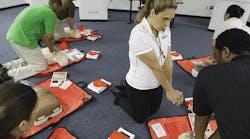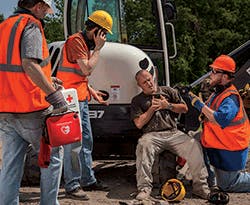Making Safety Count: Effective Training for the Workplace
Too often and for too many employees, mandatory training is seen as a bother or inconvenience that disrupts a busy workday and results in work piling up. At the end of the training, the employee downloads the digital certification, turns it in and gets back to the job at hand.
But what if the training is on workplace safety? Do we really want employees rushing through a course, instead of focusing on knowledge and skills that may one day prove the difference between life and death on the job?
On-the-job accidents and illnesses continue to present a major issue for companies in the United States. Preliminary numbers for 2013 from the Bureau of Labor Statistics show that 4,405 workers across multiple U.S. industries were killed on the job – an average of 85 each week. Accidents and illness can result in human tragedy, lost manpower and missed production deadlines.
The construction industry, characterized as "high hazard" by OSHA, is an area in which proper safety training is essential. But all industries must consider the quality of their training and ensure that it keeps up with changes and innovations.
The segment of the construction industry involved in the wireless industry is an example in which the growing demand for wireless and broadcast communications continues to spur a dramatic increase in communication tower construction and maintenance. Employees regularly climb towers in excess of 2,000 feet tall, and they do it throughout the year in all weather conditions. OSHA recorded 13 communication tower-related fatalities in 2013, but as more towers are built, that number may well continue to grow each year.
With statistics like these, safety training for employees cannot be a "check the box" experience. The question companies face is how to provide training that enables employees to learn and retain the skills and knowledge they need to respond to a real-world emergency.
For most companies, training starts with OSHA standards that require the employer to train employees in the safety and health aspects of their jobs. Other OSHA standards make it the employer's responsibility to limit certain job assignments to employees who are "certified," "competent" or "qualified" –meaning that they have had special previous training, in or out of the workplace. Many companies, unions and other organizations also require employees to successfully complete training recommended by OSHA for worksite, insurance and job-bidding purposes.
Companies seeking training that meets OSHA standards look to organizations such as the Health & Safety Institute (HSI), an Oregon-based company that is an authorized provider of OSHA training. HSI recently partnered with the American Red Cross to deliver OSHA 10- and 30-hour training for companies. It's up to these and other training providers to keep abreast of the most effective ways in which to teach safety to employees.
Simulation Learning
How can companies ensure their safety training is keeping employees awake and learning?
One of the most successful new instructional tools to emerge with the rise of new technologies is "simulation learning," which allows learners to test their knowledge of instructional materials using online interactive, scenario-based simulations. These programs offer multiple scenarios in which to test a concept or skill. In any given scenario, students may select from a number of possible actions, each of which results in further situations and possibilities based on the course taker's choice.
Researchers have found the following benefits to simulation learning:
A no-risk experience: Virtual interaction offers a safe environment in which to test knowledge with no fear of causing actual harm. Research shows that no-risk environments allowing for unlimited attempts at mastering knowledge and decision-making results in greater learner confidence.
Real-world scenarios: Simulation learning is effective because virtual scenarios can offer engaging psychological realism that bridges the gap between the classroom and the real world. Learners stimulated by realism retain information more effectively.
A new way to train: Although simulation learning is not intended to be a game, many individuals find the video-game aspects of the interactions engaging. Course takers can train anytime and anywhere they have access to a computer.
Practice makes perfect: Simulation learning allows learners to repeatedly test their skills and knowledge at their own pace and in a variety of scenarios; this increases retention of knowledge and leads to automatic responses.
In a 2014 survey conducted by Northwestern University's Kellogg School of Management, researchers questioned 4,888 Red Cross trainers on their views about simulation training. The majority of respondents said that simulation learning is a good addition to current teaching methods, and they are willing to use it in their training.
In a separate Red Cross-sponsored meta-analysis of dozens of U.S. Department of Education studies and interviews with first responders and cognitive experts, researchers found that when combined with traditional classroom experience, simulation learning is more effective in preparing people to act in a crisis than classroom learning or online learning alone.
"The value for me," said a paramedic, "is being able to make mistakes in a low-pressure environment and then learning from your mistakes, and then doing that repetitive action. So that when you do have the pressure on you and you know you have to perform with that pressure, you are able to do it because you have seen it done and felt it before."
Stephen Rieve is a senior director of preparedness, health and workplace safety programs at the American Red Cross. To learn more about Red Cross workplace training that meets OSHA standards, call 1-800-567-1487 or visit RedCross.org/SafetyTraining.
Sidebar: Spanish-Language Training Important in Construction Industry
When it comes to safety in the construction industry, companies have an important demographic to consider: nearly one in four construction workers (24.4 percent) is Latino, compared to 15.4 percent of all employed workers, according to the U.S. Bureau of Labor Statistics (BLS).
Work-related fatalities in 2013 rose for Latino workers. According to the BLS, 797 Hispanic or Latino workers were killed from work-related injuries in 2013 – 7 percent higher when compared to 2012.
Of the total fatalities for Latinos, 527 (or 66 percent) involved foreign-born workers. Specific studies of Mexican-born workers show that this population accounted for 352 – or 42 percent – of the 845 fatal injuries among all foreign-born workers. The BLS data also shows that fatalities among contract or temporary workers are on the rise, with 734 contractors dying as a result of work-related injuries in 2013, up from 715 in 2012 and 542 in 2011, when BLS began collecting data.
These statistics strongly suggest that proper safety training is even more important for companies with Latino employees, especially those in which the employees do not speak English or understand English with proficiency.

